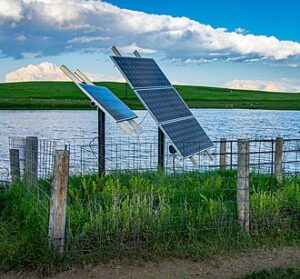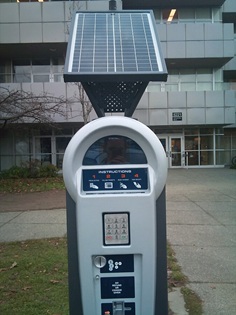The world’s first solar power plant in history (link in Dutch) was constructed by Frank Shuman. His aim was to liberate us from fossil fuels. He was far ahead of his time – but he got caught by the First World War.

Cheaper and better
On a scorching hot day in 1913, inventor Frank Shuman opened the valves of an entirely new system, in Egypt. The equipment consisted of long rows of parabolic collectors made of glass and steel; intended to generate solar power. When Shuman switched on the system, a huge steam engine started to hiss loudly. It squirted water all over the land, with huge power: more than 22,000 litres of water per minute, fully om solar power.
Shuman intended to convince the world of solar power; that it was cheaper and better than coal or oil. Just 1% of the energy on the Sahara desert could supply the entire world of energy. His invention was fantastic – but unfortunately it was overtaken by the First World War, and the discovery of cheap oil deposits. After that, it would take several decades before mankind would arrive at the same point.
Make use of the greenhouse effect
Frank Shuman was an inventor. Among others, he invented glass reinforced with metal wire, that prevented for instance light domes to burst. His factory supplied the entire United States with reinforced glass, and that lent him financial independence. Therefore, he could direct his inventive mind to other subjects.
Back then, coal was the most important energy source. It was used among others to power steam engines. That led to a huge consumption: about 200 million tons of coal, yearly. But it also led to much environmental damage. Therefore, Shuman turned his attention to solar energy. His interest in the subject had been ignited among others by the power of glass to retain warmth, like in a greenhouse. For sunlight passes glass uninterruptedly. But the heat waves emitted by the heated surface will not be passed through. That’s why it is hotter in the greenhouse than outside.
Shuman wanted to use this principle to ‘catch’ solar energy. In his garden, he tried to transfer solar power to a machine. He didn’t use water but ether, a liquid with a much lower boiling point than water. He fitted the boiler to his son’s toy steam engine, that started to move right away. In doing so, he proved that it would be very simple to transfer sunlight into mechanical energy.

Solar power plant needs to be cheap
In a subsequent larger installation, pipes ran through ‘heat chests’ of 100 m2, in which water was being heated. This allowed him to run a 4 pk steam engine. Proudly, Shuman invited people to come and have a look at his invention. He further improved his installation with better boilers, an additional layer of glass and mirrors that heated the water up to even 120oC. Now he could power an improved steam engine of 25 pk.
But he knew that investors would not be lured by mere idealism. The solar power station would have to be efficient and cheap. Cheaper than a coal-fired system. But in order to arrive there, he needed a lot of sunshine – more sunshine than he could have at his disposal in the US. Therefore he left for Egypt in 1911, one of the best solar irradiated places on Earth.
The desert would flower
He was lucky. In the same year, the British field marshal lord Kitchener was appointed head consul of Egypt, that was under British control from 1882 onwards. Kitchener wanted to improve the country’s economy. Therefore he had to irrigate the country. The British had tried to do this, using conventional steam engines – but Egypt didn’t have any coal of its own. This had to be imported all the way from Wales. A solar system was much cheaper.
Shuman arranged a meeting with Kitchener, who immediately grasped the importance of irrigation powered by solar radiation. In 1912, Shuman started the construction of a solar powered system in Maadi, just South of Cairo. He trapped the sunlight in boxes. But the physicist Charles Boys, who had been asked by investors to review the project, recommended the use of parabolic mirrors. This rendered the project much more expensive – and therefore it needed to become much smaller. Of the planned 1000 pk, just 85 pk remained. In June 1913, the over 1,200 m3 installation was finished at last.
Adjustable
The parabolic mirrors concentrated solar irradiation on the boiler in the centre of the reflective ‘trough’. Each trough was 62.5 metres long and adjustable, allowing it to follow sunlight all day long. The sun heated up the water in the boilers. These were made of blackened foundry iron, and encapsuled by glass. Just like in a greenhouse, the glass retained the heat. From the boilers, water vapour was transferred to a steam engine that produced 50-60 pk. The steam engine was fitted to a generator that produced enough electricity to power a pump with a capacity of 22.712 litres per minute. In a condenser, steam from the steam engine was transferred back to water. From there, it was ed back into the installation, where it would be heated up by the sun again.
Lord Kitchener attended the opening ceremony. As he saw that the installation pumped more than 400,000 litres of water on the fields, he offered Shuman to finance more installations. The solar driven heater could easily compete with a coal-fired installation. ‘Solar energy no longer is an “interesting option” anymore, but reality now,’ Shuman wrote in 1914. He calculated that a solar-powered unit of 51,800 km2 in the Sahara would produce enough energy to power the whole world.
Into oblivion
But the First World War prevented this plan. Shuman was sent back home, and the Maadi installation was abandoned. In that same year, Great Britain devoted its energy fully to the oil fields discovered in Persia. That choice dealt a decisive blow to Shuman’s solar adventure. The Brits lost their interest. Matters became worse as Shuman died in 1918, aged 56. It would take many years for his project to be revived. But we now know that the future of energy supply lies in solar power.
Interesting? Then also read:
Solar energy: revolutionary developments
Drivers for renewable energy development
Towards a sustainable grid
